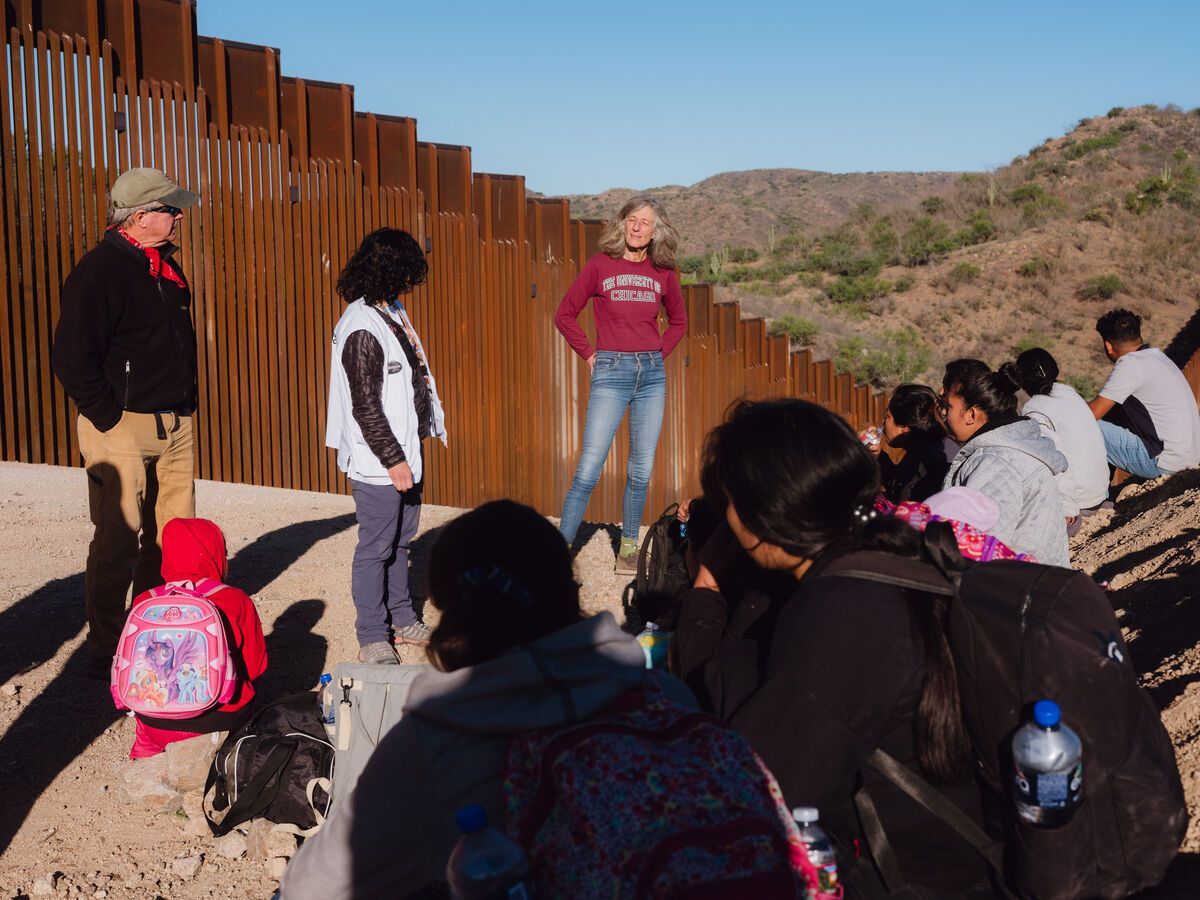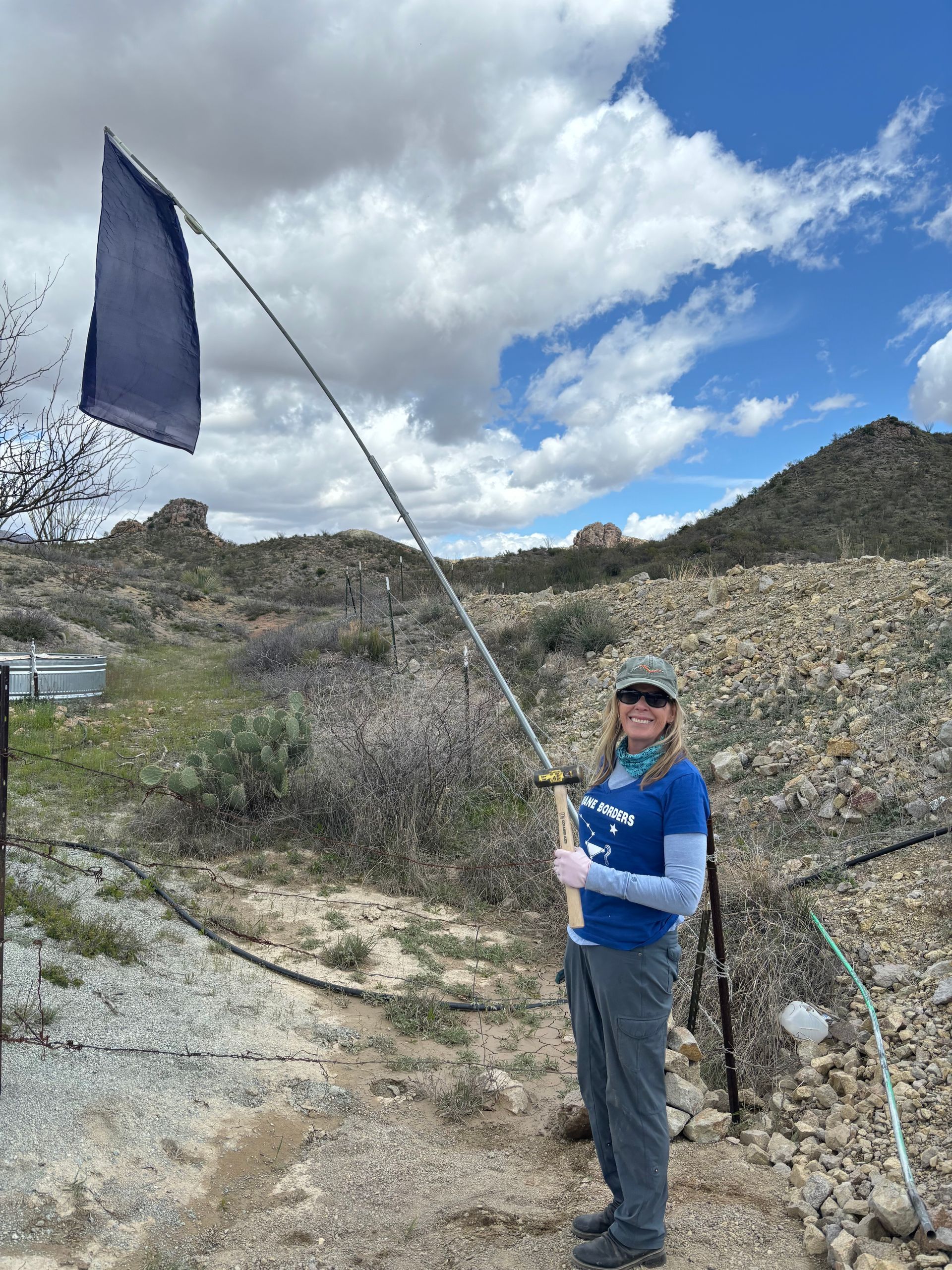DOCTORS WITHOUT BORDERS VISITS ARIZONA
spring 2024

AIDING A MOTHER EAST of SASABE, AZ
-
Photo Credit: Chris Lee
In late 2023, when Humane Borders issued a plea for medical help for newly-arriving asylum seekers in Arizona, Doctors Without Borders (Medicines Sin Fronteras, MSF) quickly answered the call.
During a five-week period in April and May 2024, a team from Doctors Without Borders conducted an assessment of migrant medical needs along the Arizona/Mexico border from Nogales to Yuma, leaving no stone unturned.
In the image on the left, Dr. Belen Ramirez, MSF Project Coordinator, carries an 8-month-old baby as she speaks with the infant's mother on the border wall road east of Sasabe, Arizona. The Guatemalan woman and her two children recently arrived at the end of the wall, miles from food, water, or shelter and in some of the most mountainous terrain in the region.
The nursing mother was dehydrated and couldn't produce enough breast milk for her baby. Dr. Ramirez provided the mother with clean drinking water so she could prepare formula for her infant daughter. "There is a humanitarian medical crisis happening here," Belen later told the Arizona Daily Star.
AT A makeshift migrant refuge
-
PHOTO CREDIT: HUMANE BORDERS
Doctors Without Borders spent many days assisting local humanitarian volunteers at a temporary refuge for asylum seekers along the border wall near Sasabe. While primitive, the makeshift refuge was established to save lives and reducing suffering during temperature extremes--providing shade, water, and food to families seeking asylum as they await Border Patrol pickup.
While the doctors provided suggestions and donated some items to improve safety and sanitation at the camp, they expressed admiration and support for the several organizations that worked tirelessly for months to provide humanitarian aid.
“I’m personally in awe,” Ramirez told the Daily Star. “It’s eye-opening for us to see volunteers from 20 years old to 88 years old. We found an amazing community here.”
Doctors Without Borders identified the Sasabe area as the one in most dire need of support. Some temporary makeshift shade areas east of Sasabe are a place where families can rest, get water and a snacks, and be greeted with smiles and hugs after their long journeys while awaiting Border Patrol pickup.

AT THE BORDER WALL
-
Photo Credit: Chris Lee
From left to right: Kirk from Humane Borders, Dr. Ramirez from Doctors Without Borders, and Christy from the Tucson Samaritans greet people seeking asylum about 20 miles east of Sasabe.
The cooperation among Tucson-based humanitarian groups and Doctors Without Borders has turned what could have been a deadly situation into one that is somewhat more orderly and manageable. However, more work is to be done in this area, assuming current migration patterns continue.
children where no child should be
-
photo credit: andy winter
A small child is dwarfed by the border wall east of Sasabe, Arizona.
Beginning in the spring of 2023, migration patterns changed and humanitarians encountered more families with infants and small children at the border wall.
The result has been: fewer people continuing to cross the desert and more refugees from all over the world crossing the border and surrendering and exercising their right to seek asylum.
While we most often encounter children with families, there are some cases in which they are traveling within a group, most hoping to be reunited with family members in the U.S.
AWAITING border patrol pickup
-
photo credit: andy winter
The Border Patrol has stepped up its presence along the wall road east of Sasabe, Arizona, with several van pickups occurring on most days. Here, asylum seekers line up to be transported in Border Patrol vehicles for processing.
Typically, women and children are transported first, with men waiting longer for pickup. Families may or may not be separated during this time, depending on the agents on duty.
One key role that Humane Borders and other humanitarian groups play during this time is to bear witness--ensuring that everyone is treated with respect.
visiting shelters in northern mexico
-
photo credit: Humane Borders
The assessment team from Doctors Without Borders visited two shelters in Sonoyta, Sonora during their April 2024 visit--Casa de Esperanza and Casa De Migrantes.
Pictured (left to right) Susannah and Tom from Humane Borders, Dr. Nico Petty from Doctors Without Borders, Dr. Belen Ramirez from Doctors Without Borders, and Carol with Humane Borders and Samaritanos Sin Fronteras.
letting kids be kids
-
photo credit: chris lee
As Doctors Without Borders visited the wall east of Sasabe, they saw these children blowing bubbles, as captured in this poignant photograph.
While the encounters that humanitarians have with children are usually brief, we find ways to let kids be kids--giving them stuffed toys, soap bubbles, or kicking a soccer ball at the makeshift refuge for asylum seekers.
Volunteer Andy also shared his dog, Rafa, with curious kids at camp, referring to Rafa as his "therapy dog."
helping at the makeshift camp near sasabe
-
photo credit: humane borders
Humane Borders assists Doctors Without Borders and local humanitarian groups as needed at the refuge for asylum seekers near Sasabe. Our work consists of greeting asylum seekers, folding blankets, cleaning up temporary shaded areas, and hauling trash from the area.
In this photo, Joel and Rebecca from Humane Borders take a break from working to enjoy a lighter moment.


Flagging a well east of sasabe
-
photo credit: humane borders
One of the most critical needs identified by Doctors Without Borders and others in the Sasabe area is the absence of reliable, safe drinking water.
Here, Laurie from Humane Borders puts up a blue flag (the universal symbol of water) with permission from a local rancher. The rancher has a series of wells throughout his property that flow through a drinking fountain and into cattle tanks like this. This rancher estimates 35 migrants have lost their lives on his property in recent years. He laments, "No one should die on my ranch because they don't have access to water."
please donate now to support our lifesaving work
Our work at Sasabe is in addition to maintaining the interior desert runs that Humane Borders traditionally operates. If you're interested in supporting our work along the border wall and in the remote desert, please consider giving today!
©2022 | All Rights Reserved | Humane Borders
Website powered by Neon One
